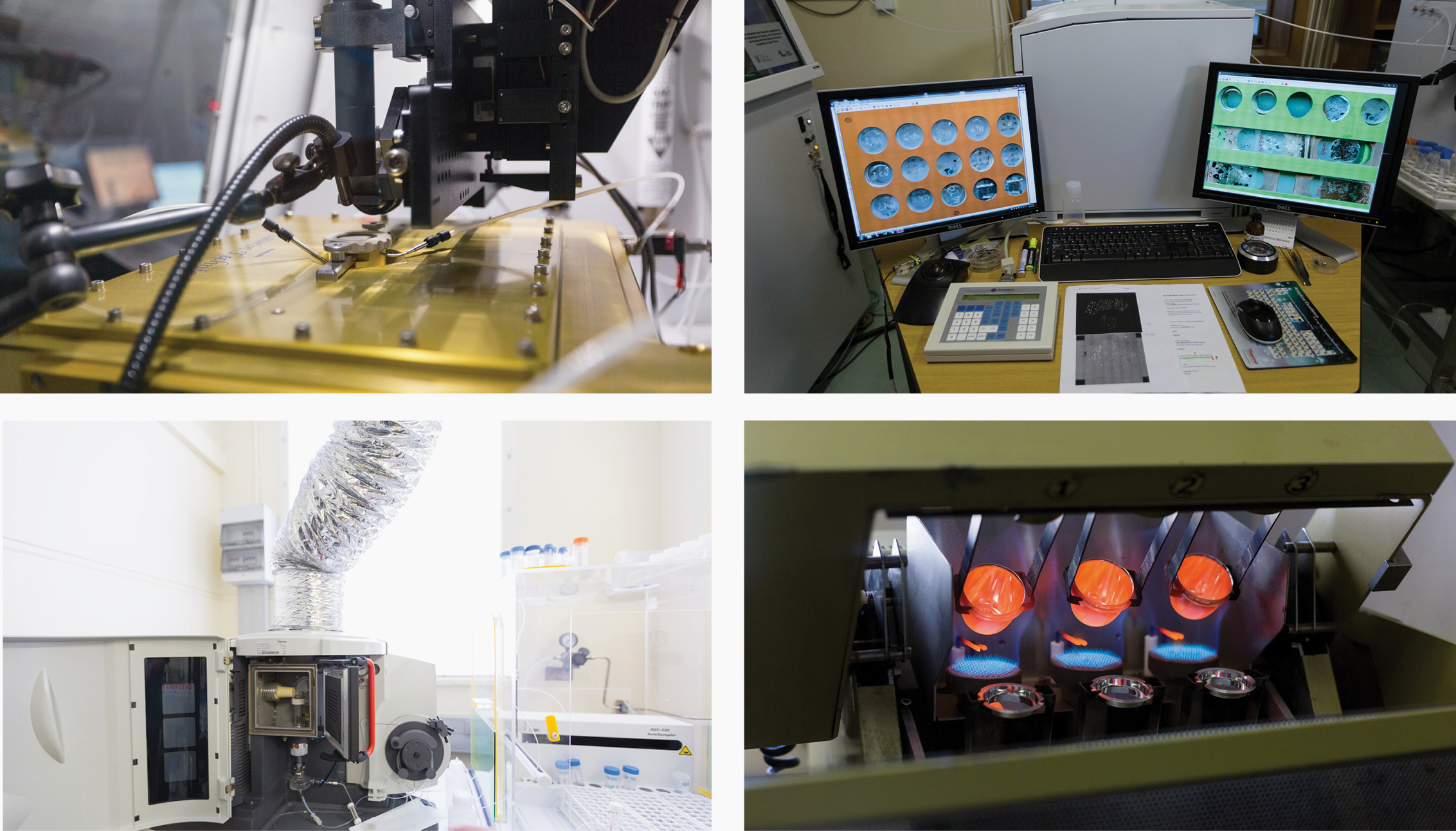ICP-MS & XRF
|

|
The ICP-MS & XRF unit at Stellenbosch University in the Western Cape performs elemental analysis on solution and solid samples, either by Solution ICP-MS & -AES, an Elemental Analyser to measure CHNS, XRF for major oxides and minor elements in rock or soil samples, and LA ICP-MS to measure whole-rock or in-situ mineral trace elements.
>>Online Analysis request & Quotation – SA clients
>>Online Analysis request & Quotation – Non-SA clients
Solution ICP-MS
Most of the elements on the periodic table, with the exception of C, H, O, N, the halides & inert gasses can be analysed, in the concentration range of hundreds of mg/L to ng/L. Major and minor elements down to mid-ppb values are measured on a Thermo ICap 6300 ICP-AES, while trace and ultra-trace analysis is done on an Agilent 7900 ICP-MS or Agilent 8800 QQQ ICP-MS. Data is quantified with calibration solutions prepared from NIST traceable standards, and quality control procedures according to US EPA guidelines are followed to ensure accuracy of data. Samples can be prepared by the client, or we can do a microwave digestion on a large variety of samples.
Laser Ablation ICP-MS
Trace element analysis
A Resolution 193nm Excimer laser ablation system from Applied Spectra is connected to an Agilent 7700 ICP-MS for most of the trace element analysis, using spot sizes between 20 and 100µm. Trace elements in bulk rock samples are analysed on polished mounts prepared from XRF fusions. Individual minerals such as oxides, sulphides or gold in grain mounts, thin- or polished sections grains are also analysed for their trace element compositions. Mounted and polished NIST standards and certified reference materials are used for quantification, using standard bracketing. Data is processed using LADR software from Norris Scientific.
U/Pb isotope analysis
A Thermo Element 2 SF ICP-MS is connected to our laser abltion system to measure U/Pb isotope ratios in minerals such as zircon, rutile and monazite for the purpose of age determinations. The CAF ICP unit do not offer a geochron service, but researchers can make use of our instruments to acquire and process their own U/Pb data. Grain mounts can be prepared in our labs, and CL images acquired at the SEM unit that are to be used in setting the precise location of the U/Pb analysis spot. Users are assisted in setting up the sample spots to be analysed (remote access to the laser terminal is also possible), as well as how to use our Iolite software to process the LA ICP data themselves. Users need to do all data interpretation and finalisation for publishable data.
X-ray Fluorescence Spectrometry (XRF)
XRF is ideal for rapid and accurate whole bulk elemental analysis in rock or soil samples. The gas-flow proportional counting detector and scintillation detector, or a combination of the two, are used to cover the elements fluorine to uranium. Major elements are analysed on a fused glass bead and trace elements are analysed on a powder briquette. A wide range of international (NIST®) and national (SARM®) standards is used in the calibration procedures and quality control (precision and accuracy) for both major and trace element analyses. Detection limits for the elements quoted, depending on the matrix (combination of elements present), are typically 0.5 ppm. Loss on Ignition (LOI) is a test used in XRF major element analysis which consists of strongly heating a sample of the material at a specified temperature, allowing volatile substances to escape or oxygen is added, until its mass ceases to change. The L.O.I. is made of contributions from the volatile compounds H2O+, OH-, CO2, F, Cl, S; in parts also K, Na (if heated for too long); or alternatively added compounds O2 (oxidation, e.g. FeO to Fe2O3), later CO2 (CaO to CaCO3). In pyro-processing and the mineral industries such as lime, calcined bauxite, refractories or cement manufacture, the loss on ignition of the raw material is roughly equivalent to the loss in mass that it will undergo in a kiln, furnace or smelter.
Elemental Analysis
An Elementar Vario EL Cube Elemental Analyzer is available to measure C, H, N & S in a variety of samples, including soil, pharmaceutical, animal tissue, food & bio-fuel, with sample sizes from 1mg to ~ 1g.
Protein determination can be done by applying a correction factor to the measured nitrogen content of your food or animal feed sample. This is much quicker than the traditional Kjeldahl method. At the same time you will also obtain C, H and S values, as the instrument always measures all 4 elements.
Sample preparation for EA
We can only assist with drying of your samples if needed, you need to ensure the samples were appropriately prepared depending on the sample type.

